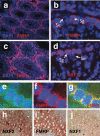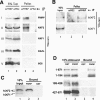The fragile X mental retardation protein interacts with a distinct mRNA nuclear export factor NXF2
- PMID: 16790844
- PMCID: PMC1524883
- DOI: 10.1261/rna.94306
The fragile X mental retardation protein interacts with a distinct mRNA nuclear export factor NXF2
Abstract
Loss of fragile X mental retardation protein, FMRP, causes the fragile X syndrome. Highly expressed in the brain and testis, FMRP has been implicated in the transport and translation of specific mRNAs. Here we show that FMRP and the mRNA nuclear export factor NXF2 co-express in the mouse male germ cells and hippocampal neurons and that FMRP associates with NXF2 but not with its close relative NXF1. We thus hypothesize that FMRP and NXF2 may act in concert to promote the nucleocytoplasmic transport of specific mRNAs in male germ cells and neurons.
Figures



Similar articles
-
Fragile X mental retardation protein FMRP and the RNA export factor NXF2 associate with and destabilize Nxf1 mRNA in neuronal cells.Proc Natl Acad Sci U S A. 2007 Jun 12;104(24):10057-62. doi: 10.1073/pnas.0700169104. Epub 2007 Jun 4. Proc Natl Acad Sci U S A. 2007. PMID: 17548835 Free PMC article.
-
The nuclear microspherule protein 58 is a novel RNA-binding protein that interacts with fragile X mental retardation protein in polyribosomal mRNPs from neurons.Hum Mol Genet. 2006 May 1;15(9):1525-38. doi: 10.1093/hmg/ddl074. Epub 2006 Mar 28. Hum Mol Genet. 2006. PMID: 16571602
-
The C terminus of fragile X mental retardation protein interacts with the multi-domain Ran-binding protein in the microtubule-organising centre.J Mol Biol. 2004 Oct 8;343(1):43-53. doi: 10.1016/j.jmb.2004.08.024. J Mol Biol. 2004. PMID: 15381419
-
Identification of messenger RNAs and microRNAs associated with fragile X mental retardation protein.Methods Mol Biol. 2006;342:267-76. doi: 10.1385/1-59745-123-1:267. Methods Mol Biol. 2006. PMID: 16957381 Review.
-
New insights into fragile X syndrome: from molecules to neurobehaviors.Trends Biochem Sci. 2003 Mar;28(3):152-8. doi: 10.1016/S0968-0004(03)00033-1. Trends Biochem Sci. 2003. PMID: 12633995 Review.
Cited by
-
Inactivation of Nxf2 causes defects in male meiosis and age-dependent depletion of spermatogonia.Dev Biol. 2009 Jun 1;330(1):167-74. doi: 10.1016/j.ydbio.2009.03.022. Epub 2009 Apr 1. Dev Biol. 2009. PMID: 19345203 Free PMC article.
-
Spinal muscular atrophy: the role of SMN in axonal mRNA regulation.Brain Res. 2012 Jun 26;1462:81-92. doi: 10.1016/j.brainres.2012.01.044. Epub 2012 Jan 28. Brain Res. 2012. PMID: 22330725 Free PMC article. Review.
-
Short- and long-term memory are modulated by multiple isoforms of the fragile X mental retardation protein.J Neurosci. 2010 May 12;30(19):6782-92. doi: 10.1523/JNEUROSCI.6369-09.2010. J Neurosci. 2010. PMID: 20463240 Free PMC article.
-
The kinesin superfamily protein KIF17: one protein with many functions.Biomol Concepts. 2012 Jun 1;3(3):267-282. doi: 10.1515/bmc-2011-0064. Biomol Concepts. 2012. PMID: 23762210 Free PMC article.
-
Nxf7 deficiency impairs social exploration and spatio-cognitive abilities as well as hippocampal synaptic plasticity in mice.Front Behav Neurosci. 2015 Jul 10;9:179. doi: 10.3389/fnbeh.2015.00179. eCollection 2015. Front Behav Neurosci. 2015. PMID: 26217206 Free PMC article.
References
-
- Bakker C.E., Otero Y., Bontekoe C., Raghoe P., Luteijn T., Hoogeveen A.T., Oostra B.A., Willemsen R. Immunocytochemical and biochemical characterization of FMRP, FXR1P, and FXR2P in the mouse. Exp. Cell Res. 2000;258:162–170. - PubMed
-
- Bardoni B., Davidovic L., Bensaid M., Khandjian E.W. The fragile X syndrome: Exploring its molecular basis and seeking a treatment. Expert Rev. Mol. Med. 2006;8:1–16. - PubMed
-
- Cullen B.R. Nuclear mRNA export: Insights from virology. Trends Biochem. Sci. 2003;28:419–424. - PubMed
-
- Darnell J.C., Mostovetsky O., Darnell R.B. FMRP RNA targets: Identification and validation. Genes Brain Behav. 2005;4:341–349. - PubMed
-
- Devys D., Lutz Y., Rouyer N., Bellocq J.P., Mandel J.L. The FMR-1 protein is cytoplasmic, most abundant in neurons and appears normal in carriers of a fragile X premutation. Nat. Genet. 1993;4:335–340. - PubMed
Publication types
MeSH terms
Substances
LinkOut - more resources
Full Text Sources
Medical
Molecular Biology Databases
